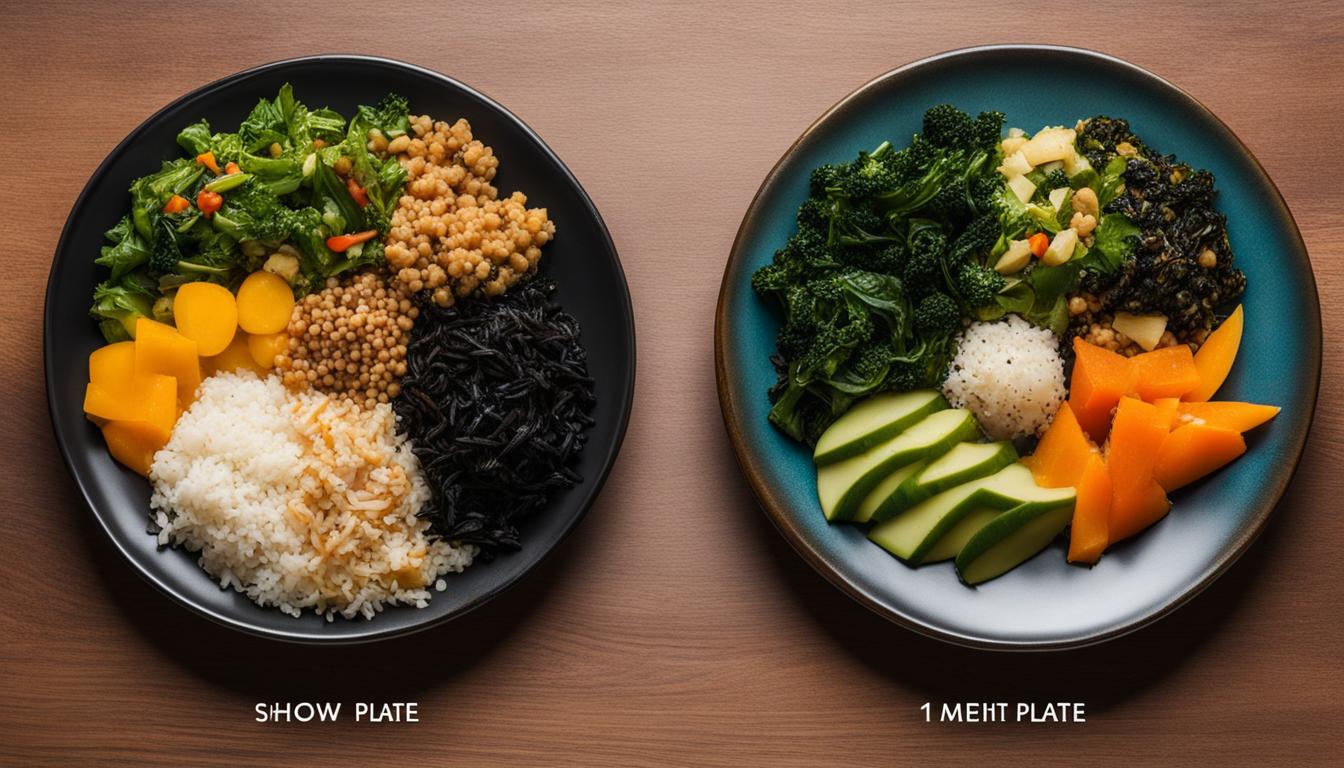When it comes to choosing a diet plan, there are countless options available. However, two of the most popular and well-known diets are the Atkins and South Beach diets. While they may seem similar on the surface, there are key differences between the two that can affect your weight loss journey and overall wellness goals.
In this section, we will explore the main differences between the Atkins and South Beach diets, helping readers understand which one may be a better fit for their wellness journey. By the end of this article, you’ll have a clear understanding of the key principles, pros and cons, and differences in macronutrient composition between these two popular diets.
Key Takeaways:
- The Atkins and South Beach diets are two popular options for weight loss and improving overall wellness.
- Understanding the differences between the two can help individuals make an informed decision about which diet plan aligns better with their goals and preferences.
- The Atkins diet places a heavy emphasis on low carbohydrate intake and has specific phases involved in the diet program.
- The South Beach diet focuses on carbohydrates, fats, and proteins, with three phases in the diet plan.
- Weighing the pros and cons of both diets is essential when choosing the best fit for your needs.
Overview of Atkins and South Beach Diets
Before diving into the key differences between the Atkins and South Beach diets, let’s take a brief look at their overall objectives and principles.
The Atkins diet, developed by Dr. Robert C. Atkins, emphasizes low carbohydrate intake to help the body burn fat for energy instead of relying on glucose from carbohydrates. It includes four phases, with the initial phase being the most restrictive in terms of carbohydrate intake. The Atkins diet also encourages high fat and protein intake.
The South Beach diet, created by cardiologist Dr. Arthur Agatston, focuses on reducing processed carbohydrates and unhealthy fats while promoting lean protein, fiber, and healthy fats. The diet is divided into three phases, with the first phase being the most restrictive and aiming to reduce cravings and stabilize blood sugar levels.
While both diets share similarities, such as emphasizing whole foods and limiting added sugars, they have distinct differences that may appeal to different individuals depending on their goals and preferences.
Key Principles of the Atkins Diet
The Atkins diet is a low-carbohydrate, high-fat diet plan that aims to help individuals lose weight by controlling insulin levels in the body. The diet program comprises of four phases: Induction, Balancing, Fine-Tuning, and Maintenance. Each phase emphasizes a different level of carbohydrate intake and is designed to help individuals lose weight and progress towards a balanced and healthy lifestyle.
The Induction phase is the most restrictive phase, where carbohydrate intake is limited to 20 grams per day. The purpose of this phase is to kickstart the body’s fat-burning process and remove cravings for sugar and carbohydrates. In the Balancing phase, individuals begin to increase their carbohydrate intake by 5 grams per day. The Fine-Tuning phase allows for a further increase in carbohydrate intake, ensuring that individuals are gradually reintroducing carbohydrates to their diet. Finally, the Maintenance phase is designed to maintain an individual’s weight loss and healthy lifestyle by allowing for a wide range of food choices while emphasizing the importance of healthy eating habits.
| Phase | Carbohydrate Intake |
|---|---|
| Induction | 20 grams per day |
| Balancing | 25-30 grams per day |
| Fine-Tuning | 50-80 grams per day |
| Maintenance | 100+ grams per day |
The Atkins diet emphasizes eating foods high in protein and healthy fats such as meat, fish, nuts, seeds, and vegetables while reducing the intake of carbohydrates and sugar. The diet also encourages the consumption of dietary fiber, which helps maintain healthy digestion. Although the diet plan has been known to help individuals lose weight quickly, it may not be suitable for everyone and may have potential side effects such as constipation, headaches, and bad breath.
In comparison to the South Beach diet, the Atkins diet is more restrictive in terms of carbohydrate intake and emphasizes the importance of healthy fats in one’s diet. While both diets may lead to weight loss, individuals looking for a more restrictive and structured diet plan may find the Atkins diet more suitable for their lifestyle.
Key Principles of the South Beach Diet
The South Beach Diet was introduced in 2003 by cardiologist Dr. Arthur Agatston and became popular for its focus on healthy fats, lean protein, and good carbs.
The South Beach Diet is divided into three phases, each designed to help individuals achieve specific goals:
| Phase | Objective | Duration |
|---|---|---|
| Phase 1 | Eliminate cravings for sugar and refined starches | 2 weeks |
| Phase 2 | Gradually reintroduce some of the eliminated carbs | Until desired weight is reached |
| Phase 3 | Maintain a healthy weight with a balanced diet | Ongoing |
In the South Beach Diet, individuals are encouraged to consume nutrient-dense foods, including whole grains, fruits, vegetables, lean protein, and healthy fats. The diet also emphasizes low-glycemic-index carbohydrates, which are absorbed more slowly and help control blood sugar levels.
Overall, the South Beach Diet is less restrictive than the Atkins diet and focuses on the quality of the foods consumed rather than strictly limiting certain macronutrients.
Differences in Macronutrient Composition
One of the main differences between the Atkins and South Beach diets is the macronutrient composition of each plan. While both diets emphasize reducing carbohydrate intake, there are variations in the amount and type of macronutrients consumed.
Atkins places a greater emphasis on high-fat foods, such as meats, cheeses, and oils, and allows for moderate protein intake. Carbohydrate intake is limited to 20 grams or less during the initial phase, with gradual reintroduction in subsequent phases.
In contrast, South Beach focuses on a more balanced approach to macronutrients, including lean proteins, healthy fats, and complex carbohydrates. The diet encourages the consumption of non-starchy vegetables, lean proteins, and healthy fats like nuts and seeds.
While both diets can be effective for weight loss, it’s important to consider personal preferences and health needs when choosing between them.
Pros and Cons of Atkins and South Beach
Both the Atkins and South Beach diets have their advantages and disadvantages. Here are some of the key pros and cons to consider when deciding which diet may be a better fit:
| Atkins Diet | South Beach Diet |
|---|---|
|
|
|
|
Ultimately, the best diet choice depends on an individual’s goals, preferences, and lifestyle. Consulting with a healthcare provider or registered dietitian can also help in making an informed decision.
Conclusion
As we’ve explored throughout this article, the Atkins and South Beach diets have some key differences that individuals should consider when deciding which one is right for their weight loss or wellness journey. By understanding the principles of each diet, including their approach to macronutrients and phases, individuals can determine which program aligns best with their personal preferences and goals.
While the Atkins diet emphasizes low carbohydrate intake and protein consumption, the South Beach diet focuses on selecting quality carbohydrates, lean proteins, and healthy fats. Both diets have potential benefits, including weight loss and improved blood sugar levels, but they may have different effects on individuals with certain health conditions or dietary restrictions.
Overall, it’s essential to consider the pros and cons of both diets before committing to one. Factors such as ease of adherence, potential health benefits, and potential drawbacks should be taken into account. By doing so, individuals can make an informed decision about which diet plan is the best fit for their lifestyle and wellness goals.
FAQ
Q: How does the Atkins diet differ from the South Beach diet?
A: The Atkins diet focuses on low carbohydrate intake and has four phases, while the South Beach diet emphasizes the quality of carbohydrates and includes three phases.
Q: Which diet is better for weight loss, Atkins or South Beach?
A: Both the Atkins and South Beach diets can be effective for weight loss. The choice between the two depends on personal preferences and lifestyle.
Q: Can I follow the Atkins or South Beach diet if I have food restrictions?
A: It is possible to follow both the Atkins and South Beach diets with certain food restrictions. However, it’s important to consult with a healthcare professional or registered dietitian to ensure nutritional needs are met.
Q: How long do the phases of the Atkins and South Beach diets last?
A: The duration of each phase in the Atkins and South Beach diets can vary. It is recommended to follow the specific guidelines outlined in each respective diet plan.
Q: Are there any potential health benefits associated with the Atkins or South Beach diets?
A: Both the Atkins and South Beach diets have been associated with weight loss, improved blood sugar control, and reduced risk of certain chronic diseases. However, individual results may vary.
 Skip to main content
Skip to main content


